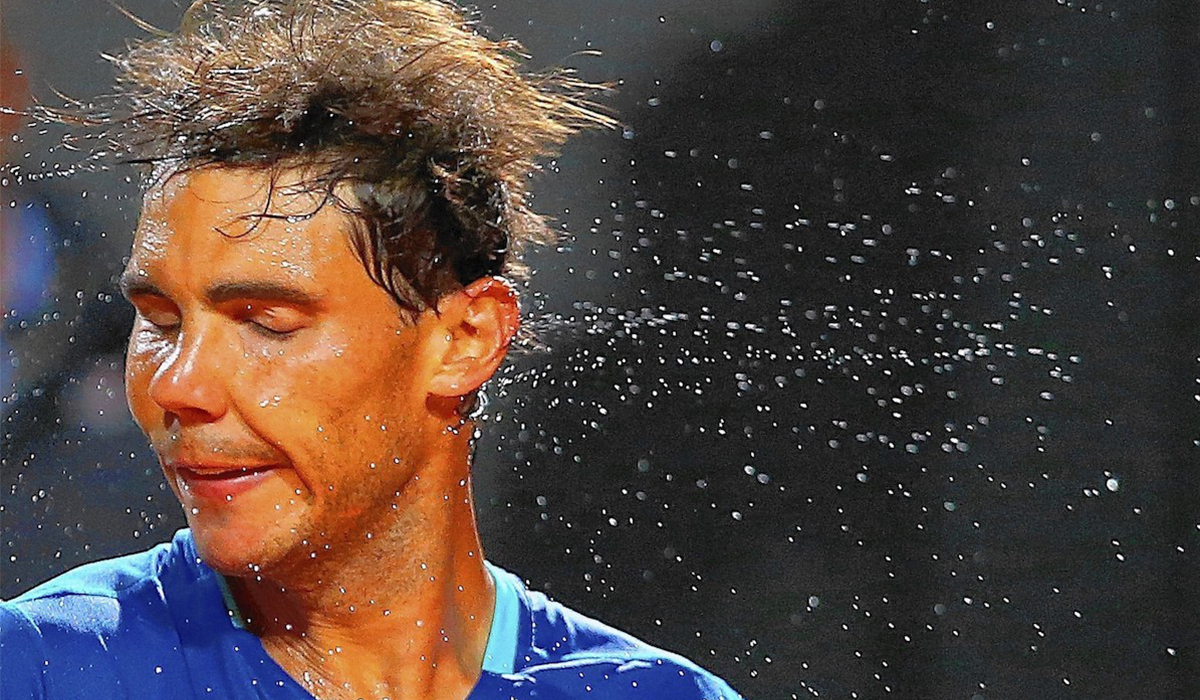
Andy Blow is a sports scientist and the founder of Precision Hydration. Unsurprisingly he’s one of the most knowledgable people I’ve met when it comes to hydration. His company and expertise has helped me better understand my own hydration needs. The purpose of this post is simple: to teach you how to stay hydrated while training/competing so you can maximise your performance. Andy will be your guide, over to you Andy…
– – –
Thanks Pat. Pat was one of the earliest high-profile athletes to use our products. It was a huge buzz to see his name pop up on the system after he’s done an Advanced Sweat Test with our Test Centre in Putney. So, when he mentioned that he gets a lot of questions about hydration from within his community, we were delighted to help by putting together a blog on how to stay hydrated when you’re out on the tennis court. So, quiet please…
Why is hydration so important?
Staying hydrated is crucial to your performance on the court.
Your body is under considerable strain when you’re pushing yourself during a match or intense training session. It’s pumping blood around your body to supply your working muscles with oxygen, remove toxic by-products, dissipate heat and regulate your core temperature.
Dehydration increases the stress your body is under during these processes and this hampers your performance. There have been a number of high profile cases of players not being able to complete matches due to hydration-related issues and heat exhaustion in recent years, including when American Jack Sock had to withdraw from his 2nd round match at the US Open in 2015 (though that was a particularly hot year at Queens!)
So, it’s important to understand the science behind hydration in order to make sure you’re doing the right things before, during and after your matches…
Why is sweat, and the sodium in it, so important?
Tennis is a high intensity sport and it’s often played in hot conditions, these two factors tend to drive high sweat rates. In fact, a study showed sweat rates in excess of 1 litre (34oz) per hour for juniors and up to 2.5 litres (85oz) per hour for older adolescents and adults. How much you sweat is important as that sweat is drawn from your blood plasma, and I’ve already mentioned all of the important roles your blood plays whilst you’re exercising.
But your sweat rate is only part of the equation. How much sodium you lose in that sweat is also critical as it’s this electrolyte that helps you absorb and retain fluid, topping up your blood plasma volume. Sodium also plays an important role in nerve impulse transmission, the absorption of nutrients in the gut, maintaining cognitive function and in muscle contraction.
You’ve probably noticed that your sweat tastes salty and some of you will have noticed that you get white marks on your skin and kit after a hard fought match. That’s because sodium is one of the main ingredients in your sweat.
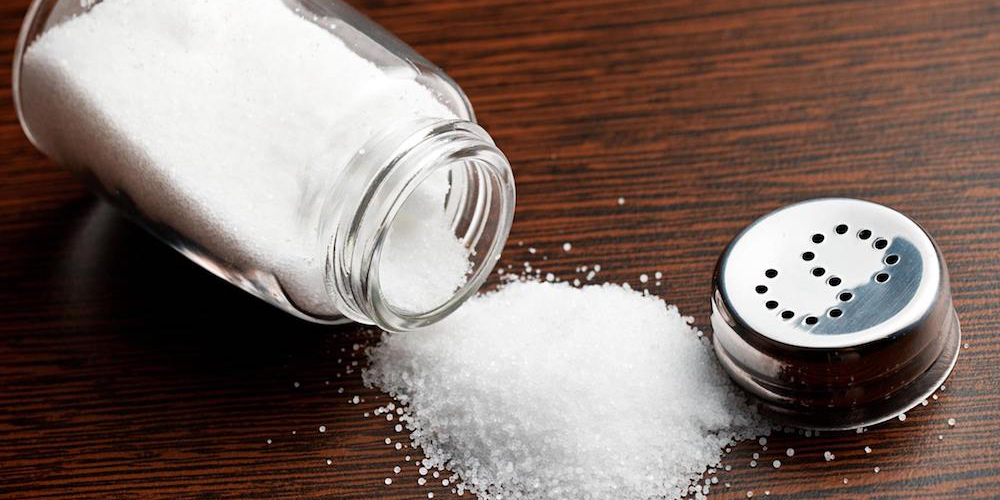
What many people don’t know is that the amount of sodium you lose in your sweat is largely genetically determined, stable and it varies dramatically from person to person. At Precision Hydration, we’ve Sweat Tested more than 3,000 athletes (including pros from the Premier League, NFL, NBA, Formula One and, of course, the tennis world) and found that the average person loses about 920mg of sodium per litre of sweat.
But about 20% of those we test lose between 1,500 and 2,000mg/l, which we classify as ‘very high’. The differences in both sweat rate and sweat sodium concentration (how much sodium is in your sweat) can mean that two players on opposite sides of the court can experience very different sodium losses over the course of a match, up to 15 times different in fact.
As well as affecting the bodily processes mentioned above, inadequate sodium and fluid replacement can also cause cramp. Hopefully, it’s becoming increasingly clear that replacing the fluids and electrolytes you lose when you’re exercising is critical if you want to maintain your performance.
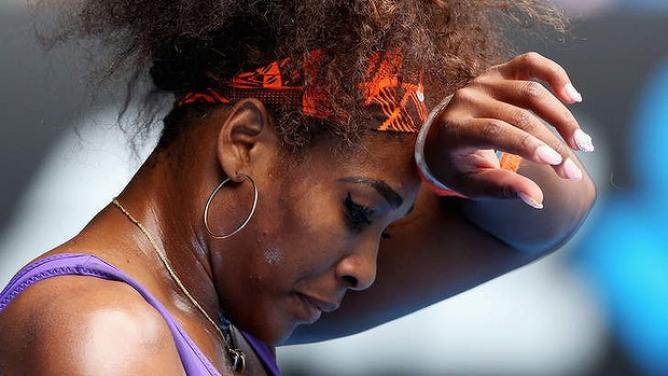
What are the challenges with staying hydrated when playing tennis?
As I’ve already said, the intensity of the sport and the conditions it’s played in often mean sweat rates are high. The fact that match length can vary significantly between 2 and 5 sets (with long, close sets compounding that) is also a challenge. These factors combined mean that sweat and sodium losses can be very high indeed, especially if you lose a lot of sodium in your sweat.
Recovery time in between matches can also be relatively short in tournament play. There is evidence to suggest many players run the risk of starting matches in a less than perfectly hydrated state. All of these challenges mean that it’s crucial to plan ahead when it comes to staying hydrated.
Ok, so how can I stay hydrated during a match?
A good tennis hydration strategy should encompass the following…
1. Aim to start the match with good hydration levels.
That’s not just about drinking water, you need to replace the electrolytes lost in your sweat too. And, by electrolytes, I mainly mean sodium, as that’s the electrolyte you lose the most of in your sweat, potassium, calcium and magnesium losses are generally small in comparison.
If you only drink water over an extended period of exercise where you’re sweating, you’re actually further diluting your blood sodium levels and are at risk of giving yourself a condition called hyponatremia (literally meaning ‘low blood sodium levels’) which has nasty side effects like headaches, nausea, vomiting and even coma and death (in extreme cases!).
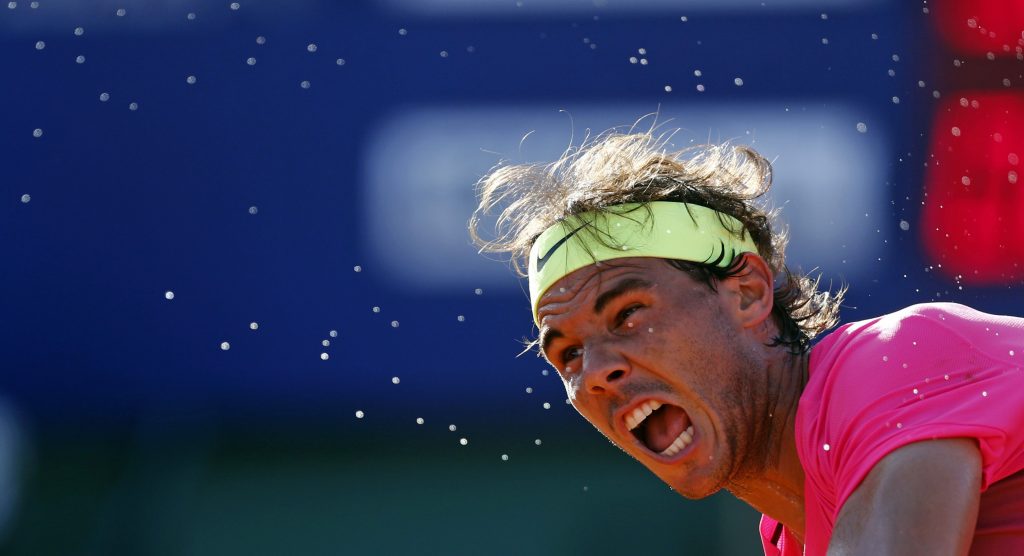
You can preload on sodium before a match by taking a strong electrolyte supplement like Precision Hydration’s 1500mg/l product. With that product, we’d recommend one serving in 500ml (16oz) of water the night before a match and another serving in 500ml (16oz) of water about 90 mins before you walk on to the court.
2. Have enough drinks and supplements on hand to get you through the longest possible match.
You should always drink to thirst, that’s the mechanism your body has evolved to tell you what it needs. However, there are some general guidelines on how much to drink in different scenarios in the Personalised Hydration Plan you can get for free by taking Precision Hydration’s Online Sweat Test. That test will also give you an idea of what strength electrolytes you need in training and matches.
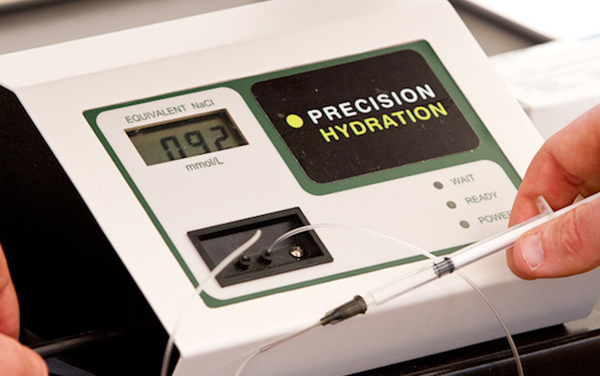
If you want to go a step further and find out exactly how much sodium you’re losing in each litre of sweat, you can also take our exercise-free, Advanced Sweat Test. You can find out more about that here.
It’s also a good idea to have plain water to hand as well as electrolyte drinks. That way, your taste buds can help dictate what your body wants at a given point in time.
3. Drink little and often, from early on in your matches to keep on top of hydration levels.
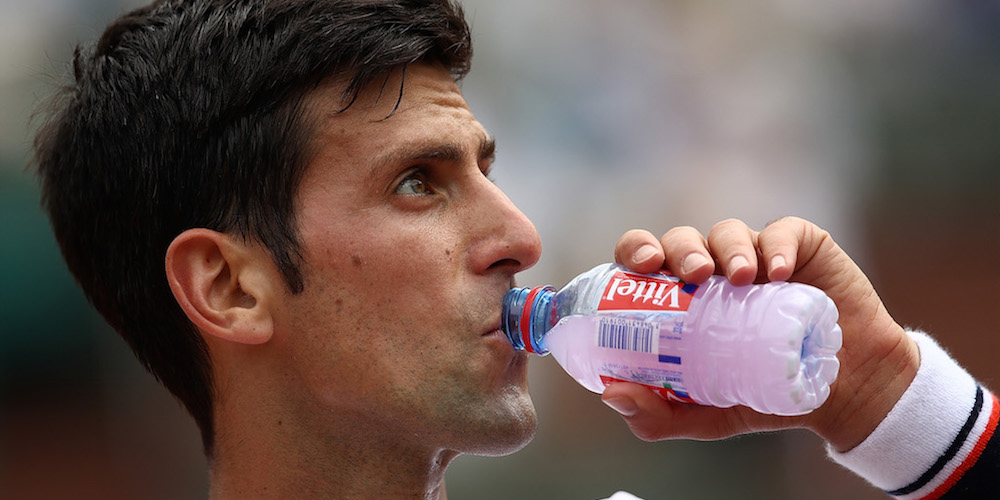
Don’t wait until it is too late as it’s not always clear how long a match will last. There are, of course, lots of opportunities for in-game rehydration with changes of ends and the breaks between sets, so there’s no excuse for not taking on some fluids and electrolytes.
4. Your fluid/electrolyte replenishment needs to be personalised.
This can be done using a combination of science (understanding your likely levels of total sweat and sodium loss), trial and error and listening to your body. Remember that your needs can be vastly different to the needs of the player on the opposite side of the net.
5. For players with very high sweat/sodium losses: Consider carrying some foods with salt in to supplement your electrolytes levels.
Think salami, cheese, pretzels, beetroot (beets), celery, spinach etc. This can be a welcome change from an electrolyte drink in the latter stages of a long match.
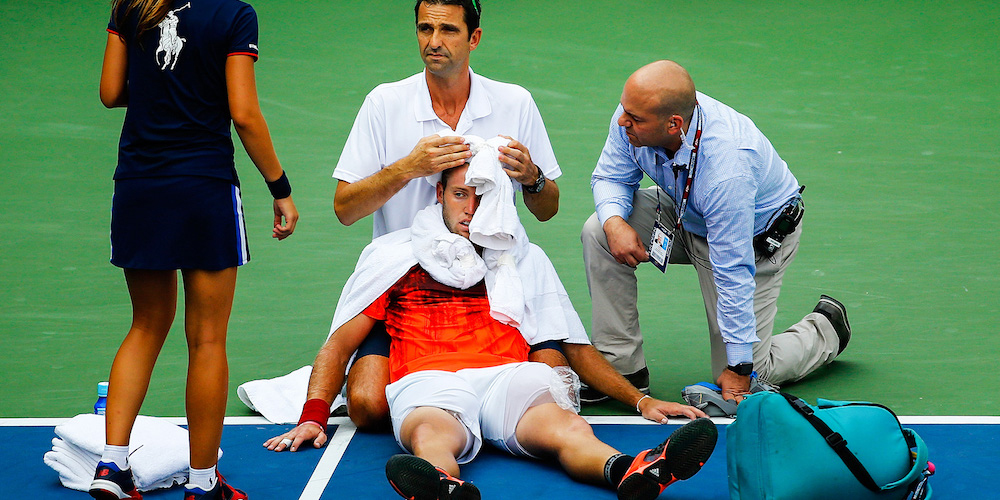
American Jack Sock collapsed on court during the 2015 U.S. Open. He had been suffering with cramp and heat exhaustion.
6) Recovery (re-)hydration after matches is a good idea, particularly matches with high sweat/sodium losses and when you’re playing again the next day.
Taking in electrolytes with your post-match fluids will help fluid retention. In some cases, like after 3/5 set matches in tournaments in hot environments, you may find higher strength sodium drinks are right for recovery, in others a more moderate strength supplement will do the job. Our 250mg/l supplements were designed with day to day hydration and recovery in mind. They’re also useful for staying hydrated on long-haul flights to and from tournaments.
If you follow these steps and refine your hydration strategy in training and competition, you’ll be better equipped to perform at your best when it counts.
Keen players, parents and coaches may also wish to read this paper for more information and tips on dealing with playing in hot and humid environments.
A word about cramps.
Despite the fact that muscle cramps are a very common phenomenon – affecting anywhere between 40 and 95% of athletes at some point in their lives depending on which surveys you want to believe – and that they have been widely studied, no-one really knows the full story about cramp yet.
The bottom line appears to be that muscle cramps are likely to have multiple causes including, but not limited to, electrolyte imbalances and neuromuscular fatigue and that, as a result, it’s likely that multiple interventions are likely to be needed to try to eliminate these different types of cramp.
There’s no ‘magic bullet’ available to kill off muscle cramping at the moment and it doesn’t look like there will be one coming anytime soon. However, if you’re not inclined to sit around twiddling your thumbs waiting for science to deliver in it’s own sweet time, there are a few things you might want to try if you want to try to get on top of the issue…
Try consuming additional sodium.
Based on my own experiences and the historical evidence I absolutely think it’s worth looking at your sodium intake in relation to your sweat output. It’s a cheap and simple exercise and has little downside to it. It’s certainly a good idea if your cramps tend to occur during or after periods of heavy sweating, in hot weather, late on during matches or if you generally eat a low sodium (or low carb) diet.
One note of caution however; If you do take on additional sodium, especially in the form of electrolyte drinks, make sure they are strong enough to make a real difference. Most sports drinks are extremely light on electrolytes (despite the claims they make on their labels), containing only about 200-500mg sodium per litre (32oz). Which, as I mentioned above, is less than half the amount of sodium the average athlete loses in a litre of sweat out on the court.
Take the extra sodium in the hours immediately before and during matches (or training sessions) that normally result in cramping and see how you get on. You’ll know pretty quickly if this is effective or not, and can fine tune your dosage to balance cramp prevention with keeping your stomach happy over time (really excessive salt or sodium intake can cause nausea).
Other strategies.
Other strategies that are far from proven, but that either make intuitive sense or have been used by athletes in the war on cramp include…
- Sports massage and stretching of the affected muscles.
- Acupuncture
- Thorough warm ups prior to cramp inducing activities.
- Mental relaxation techniques.
Although none of these are likely to offer a complete solution they are generally accessible, inexpensive and may even benefit performance in other ways, so there would seem to be little downside to giving them a try.
Want to get started with personalising your hydration strategy right away? Take our free Online Sweat Test. And, if you decide you’d like to try our all-natural, multi-strength electrolytes to personalise your strategy, use the code PATCASH15 to get 15% off your first order, courtesy of the legend himself.
If you enjoyed this post please sign up for my newsletter. It’s where I share member exclusive content not found anywhere else. Including interviews, my favourite gear, health & fitness exercises, tennis tips and more. Get access here.



